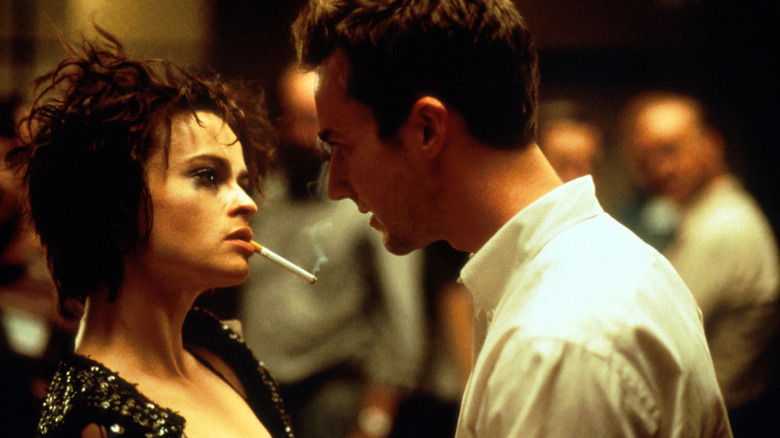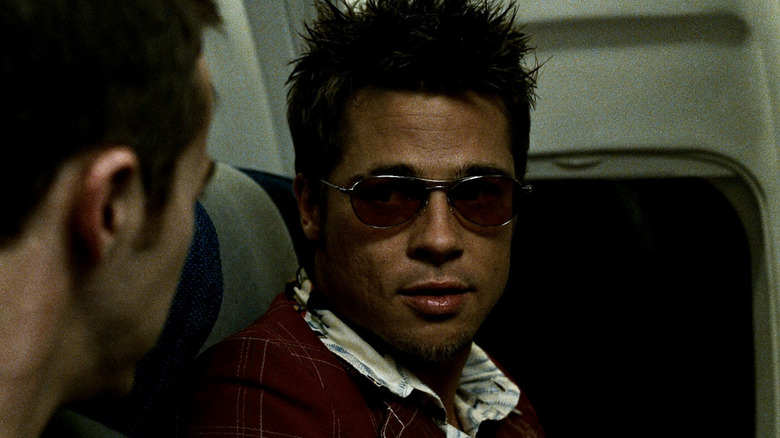The Studio Wanted To Cut One Of Fight Club's Defining Features
1999 was a weirdly great year for movies, with "The Matrix," "The Sixth Sense," "American Beauty," "The Green Mile," and a couple dozen other soon-to-be classics hitting the theaters around the same time. Joining their ranks was David Fincher's "Fight Club," the fast-paced, hyper-stylized psychological thriller about two guys who start an underground fight club that quickly escalates into a terrorist organization. It's a strange movie, and while the exact message it's trying to make with its social commentary is often disputed, but it's undoubtedly an entertaining watch.
One thing that makes the movie flow so well is the use of narration. Edward Norton's character, who technically is never given a name, talks to the audience constantly throughout the movie, providing extra context to all the crazy stuff that's happening. In the first draft of the script, however, there was no voiceover. As Fincher explained in an interview with Cinephilia Beyond:
"A lot of the typical development-speak was being thrown around: "You can't have it all in voiceover because voiceover's a crutch." The first draft had no voiceover, and I remember saying, "Why is there no VO?" and they were saying, "Everybody knows that you only use VO if you can't tell the story." And I was like, "It's not funny if there's no voiceover, it's just sad and pathetic."
The visual equivalent of stream of consciousness
They weren't entirely wrong with that line of reasoning. Voiceover in movies is sometimes crutch for lazy storytelling, a sign that the writers don't trust the audience to understand what's happening on the screen. One of the most famous examples of this, before "Fight Club," was the original cut of "Blade Runner," where the studio basically forced Harrison Ford to read five minutes' worth of narration split across the film. Most of that narration was redundant, uninteresting, and poorly delivered. As Fincher put it, it "sounds like a guy reading prose while he's sitting on the john." With both Ford and director Ridley Scott being against its inclusion, most modern "Blade Runner" fans vastly prefer the director's cut where the voiceover was removed.
The narration in "Fight Club," meanwhile, is made up mostly of the narrator's stray thoughts, guiding the viewer through sequences of events without ever calling too much attention to itself. As the movie jumps back and forth in time, showing us a skewed version of reality where Norton's Narrator sees himself as two separate people, the narration becomes a grounding presence for the viewer. Rather than tell us things that are already evident from the scenes themselves, the voiceovers here serves as the glue that helps everything stick together. Fincher compares the style to the stream-of-conscious prose of the source material:
"I remember having a conversation early on when we were discussing what the feel of the first act should be. I was saying, "It's not a movie, it's not even TV, it's not even channel-changing, it's like pull-down windows. It's like, pffpp, take a look at it, pffpp, pull the next thing down—it's gotta be downloaded. It's gotta move quick as you can think. We've gotta come up with a way that the camera can illustrate things at the speed of thought."
The 208-page novel of the same name written by Chuck Palahniuk is a similarly erratic story centered around a unique, deeply unreliable narrator. Although the movie changes and streamlines a lot of what happens in the book, the embracing of its unreliable narrator is something they stayed true to the whole way through. The stream-of-consciousness is a key part of what made the book so interesting, after all, and Fincher did right by rejecting the conventional wisdom on voiceovers.

